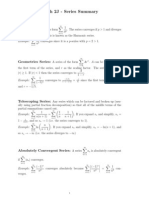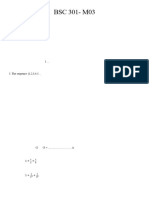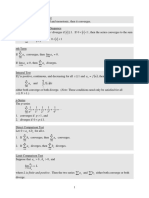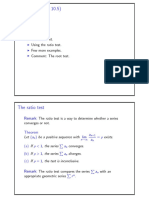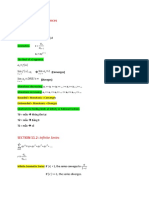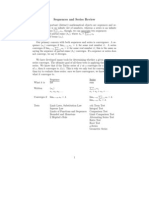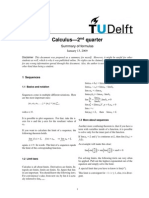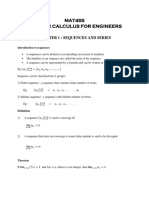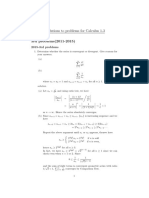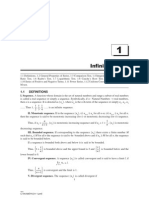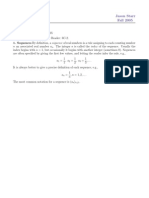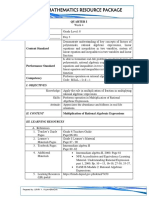Series Converge Diverge
Series Converge Diverge
Uploaded by
MuhammadSalmanCopyright:
Available Formats
Series Converge Diverge
Series Converge Diverge
Uploaded by
MuhammadSalmanOriginal Description:
Copyright
Available Formats
Share this document
Did you find this document useful?
Is this content inappropriate?
Copyright:
Available Formats
Series Converge Diverge
Series Converge Diverge
Uploaded by
MuhammadSalmanCopyright:
Available Formats
Testing for Convergence or Divergence of a Series
Many of the series you come across will fall into one of several basic types. Recognizing
these types will help you decide which tests or strategies will be most useful in finding
whether a series is convergent or divergent.
p-Series
1
is
p
n =1 n
Geometric Series
convergent if p > 1
divergent if p 1
ar
is convergent if r < 1
n 1
n =1
divergent if r 1
If a n has a form that is similar to one of the above, see whether you can use the
comparison test:
1
Example: 2
Comparison Test
n =1 n + n
(Warning! This only works if a n and bn are always positive.)
1
Pick bn = 2 (p-series)
n
(i) If a n bn for all n, and bn is convergent, then a n is convergent.
1
1
(ii) If a n bn for all n, and bn is divergent, then a n is divergent.
2 , and
an = 2
n +n n
1
converges, so by
2
n
=1
n
Consider a series bn so that the ratio
1
1
Example: n
(i), 2
converges.
a n bn cancels the dominant terms in
n =1 2 1
n =1 n + n
the numerator and denominator of a n ,
1
Pick bn = n (geometric)
as in the example to the left. If you
2
n
know whether bn converges or not,
a
1 2
lim n = lim n
try using the limit comparison test.
n b
n 2 1 1
n
1
= lim
=1> 0
n 1 1 2 n
Limit Comparison Test
(Warning! This only works if a n and bn are always positive.)
1
converges,
so
n
a
n =1 2
If lim n = c > 0 (and c is finite), then a n and bn either both
n b
1
n
converges.
n
converge
or both diverge.
n =1 2 1
Some series will obviously not
convergerecognizing these can save
you a lot of time and guesswork.
Test for Divergence
If lim a n 0 , then
n
n =1
1
n 1
n2 = 1 0
= lim
lim a n = lim 2
n
n
n n + n
1
1+
n
2
n 1
so 2
is divergent.
n =1 n + n
2
n2 1
2
n =1 n + n
Example:
is divergent.
Testing for Convergence or Divergence of a Series (continued)
If a n can be written as a function with a nice
integral, the integral test may prove useful:
Example:
n
n =1
f ( x) =
positive, and decreasing on [1, ) , then:
If f ( x)dx converges, then
1
n =1
If f ( x)dx is divergent, then
1
Example:
(1)
n 1
converges.
= lim tan 1 x
an is divergent.
n =1
n =1
= lim tan 1 t
, so
n
n =1
1
is
+1
Alternating Series Test
If (i) bn +1 bn for all n and (ii)
lim bn = 0 , then
n
1
n2
= lim
=0
3
n n + 1
n n + 1 n 2
(1) n1
(1)
n 1
n =1
bn is
convergent.
(ii) lim
2 4 4
convergent.
n +1
1
1
1
1
(i) = n + 2 , so
= n +1+
> n +1
bn +1
bn
(n + 1) 2
n
1
1
1
1
, so
n+ 2 =
, so bn +1 bn
bn
bn +1 bn
n
n =1
So
1
1
dx
2
1 x 2 + 1 dx = lim
t
1 x +1
1
+1
1
is continuous,
x +1
positive, and decreasing on [1, ) .
Integral Test
If f (n) = a n for all n and f (x) is continuous,
n2
is convergent.
n3 + 1
The following 2 tests prove convergence, but also prove the stronger fact that
converges (absolute convergence).
Ratio Test
a
If lim n +1 < 1 , then
n a
n
Example:
n
a
a n +1
> 1 or lim n +1 = , then
n a
n a
n
n
nn
1+ 3 n
n =1 3
nn
n
lim 1+3n = lim 1 n 3
n
n
3
3 3
n
n
1
lim 1 n =
27 n 3
nn
So 1+3n is divergent.
n =1 3
=
n!
a n +1
e n 1 (n + 1)!
lim
= lim
n a
n
e n n!
n
is divergent.
= e 1 lim n + 1 = , so
n
a
If lim n +1 = 1 , use another test.
n a
n
Example:
n =1
is absolutely convergent.
If lim
n! is divergent.
n =1
When a n contains factorials and/or powers of constants,
as in the above example, the ratio test is often useful.
Root Test
If lim n a n < 1 , then
n
is absolutely convergent.
a n +1
= , then
n a
n
If lim n a n > 1 or lim
n
If lim n a n = 1 , use another test.
n
is divergent.
You might also like
- Math Answers and WBDocument31 pagesMath Answers and WBnairah200029% (14)
- 3.4 Direct Comparison and Limit Comparison TestsDocument17 pages3.4 Direct Comparison and Limit Comparison TestsDileep NaraharasettyNo ratings yet
- Business Mathematics G11 Q1 M 2Document24 pagesBusiness Mathematics G11 Q1 M 2Joselito Ubaldo75% (4)
- Basic Arithmetic and Algebra PointersDocument15 pagesBasic Arithmetic and Algebra PointersNabongJoanKateNo ratings yet
- Rational Number Assessment Task 1 - Breanna LevesqueDocument5 pagesRational Number Assessment Task 1 - Breanna Levesqueapi-285806153No ratings yet
- Convergence Tests & ExamplesDocument4 pagesConvergence Tests & ExamplesNTNo ratings yet
- Chapter 13 Special Test For ConvergenceDocument23 pagesChapter 13 Special Test For Convergencenormal@backupNo ratings yet
- Infinite Series Sequence:: S U, U,, UDocument29 pagesInfinite Series Sequence:: S U, U,, UAvinash SinghNo ratings yet
- 2J - Summary of SeriesDocument4 pages2J - Summary of Seriespissed1109No ratings yet
- Important Series in CalculusDocument2 pagesImportant Series in CalculusBob leNo ratings yet
- CSU MTH182 Summer16 1.2585948.HW04Document9 pagesCSU MTH182 Summer16 1.2585948.HW04HaardikGargNo ratings yet
- Tests For The ConvergenceDocument27 pagesTests For The ConvergenceAnkitSisodiaNo ratings yet
- BSC301 CA3Document12 pagesBSC301 CA3skmirajulislam181No ratings yet
- Infinite Series1Document15 pagesInfinite Series1Dhiviyansh Punamiya OT3 - 433No ratings yet
- combinepdf__1_Document12 pagescombinepdf__1_tinamaklinNo ratings yet
- Em 8Document2 pagesEm 8rd317322No ratings yet
- Series TheoremsDocument4 pagesSeries TheoremsIsmail Medhat SalahNo ratings yet
- 11.6 Absolute Convergence and The Ratio TestDocument5 pages11.6 Absolute Convergence and The Ratio TestSuman ChatterjeeNo ratings yet
- Ratio TestDocument7 pagesRatio Testthespirit729No ratings yet
- Infinite Series Covergance-Divergance TestsDocument3 pagesInfinite Series Covergance-Divergance TestsSergey KojoianNo ratings yet
- Review: Chapter 11: 11.1: SequencesDocument4 pagesReview: Chapter 11: 11.1: SequencesRahul NayakNo ratings yet
- Infinite Series Tests ReviewDocument2 pagesInfinite Series Tests ReviewfragilewindowsNo ratings yet
- The Integral and Comparison TestsDocument7 pagesThe Integral and Comparison TestsSHareduwan KasiHmuddinNo ratings yet
- TMA1101 - Topic 07 - Sequences and SeriesDocument21 pagesTMA1101 - Topic 07 - Sequences and SeriesVenggaNo ratings yet
- Infinite SeriesDocument26 pagesInfinite SeriesAshley Jovian CorreaNo ratings yet
- Sol2 PDFDocument5 pagesSol2 PDFMaria Jose de las mercedes Costa AzulNo ratings yet
- The Ratio Test and The Root TestDocument6 pagesThe Ratio Test and The Root Testferdie526No ratings yet
- Section 11Document6 pagesSection 11Minh Triều Bùi VănNo ratings yet
- Camp 2016 Real AnalysisDocument4 pagesCamp 2016 Real AnalysisGurt DovletovNo ratings yet
- Chapter2 SequenceDocument5 pagesChapter2 Sequencemẫn lêNo ratings yet
- HL Notes PowerSeriesInvervalofConvergenceDocument2 pagesHL Notes PowerSeriesInvervalofConvergenceAndy NguyenNo ratings yet
- Sequences and Series ReviewDocument9 pagesSequences and Series Reviewcartoon_nate100% (4)
- SeriesconvergedivergeDocument2 pagesSeriesconvergedivergealemuyohannes960No ratings yet
- Chapter 2 SeriesDocument25 pagesChapter 2 SeriesAlex TanNo ratings yet
- Summary of Formulas 2Document8 pagesSummary of Formulas 2Megha TVNo ratings yet
- Concise Format of Unit-IIIDocument8 pagesConcise Format of Unit-IIIClashWithShadow -COC&MoreNo ratings yet
- Math Tutorial2Document2 pagesMath Tutorial2monkeyng.bmedNo ratings yet
- Sheet 9Document2 pagesSheet 9Kimberly RenaeNo ratings yet
- 1 Prerequisites: 1.1 1. Sequences of Real NumbersDocument2 pages1 Prerequisites: 1.1 1. Sequences of Real NumbersEmilNo ratings yet
- MAT455 CHAPTER 1 StudentDocument15 pagesMAT455 CHAPTER 1 Studentaremyrah AzlanNo ratings yet
- 1.3 Tests For Convergence: Week2 MAT455Document7 pages1.3 Tests For Convergence: Week2 MAT455simon georgeNo ratings yet
- FPM Workshop Week 4Document3 pagesFPM Workshop Week 4liuchris76No ratings yet
- Testsforconvergencewithanswers PDFDocument9 pagesTestsforconvergencewithanswers PDFRoberto Antonio Rojas EstebanNo ratings yet
- Math 31B: Sequences and SeriesDocument35 pagesMath 31B: Sequences and SeriesmaulidaNo ratings yet
- Sketch of Solutions To Problems For Calculus 1-3Document19 pagesSketch of Solutions To Problems For Calculus 1-3hongjiwan531No ratings yet
- Infinite SeriesDocument30 pagesInfinite SeriesShakti SinghNo ratings yet
- AdvMath 02 01to05 PDFDocument5 pagesAdvMath 02 01to05 PDFJohn Andrews De VeraNo ratings yet
- Lecture Note Chapter One (1)Document31 pagesLecture Note Chapter One (1)hanayetagesuNo ratings yet
- Lecture 5 BlankDocument11 pagesLecture 5 Blankaryan220202No ratings yet
- Series TestsDocument3 pagesSeries TestsShiva HarshNo ratings yet
- 14F3583C-FD06-40DA-8501-8CCA26C82525Document9 pages14F3583C-FD06-40DA-8501-8CCA26C82525gamidiyaswanth124No ratings yet
- 11.5 Alternating Series: TheoremDocument3 pages11.5 Alternating Series: Theoremangel02 AcopeNo ratings yet
- Infinite Series of Positive and Negative TermsDocument5 pagesInfinite Series of Positive and Negative TermslagrangemikhailovNo ratings yet
- Lecture Note-III (E.M-III) (RKM)Document6 pagesLecture Note-III (E.M-III) (RKM)Himanshu SahaniNo ratings yet
- Chapter 1 SequenceDocument13 pagesChapter 1 SequenceAlex TanNo ratings yet
- 18 01 Fall 2005 Lecture 30Document7 pages18 01 Fall 2005 Lecture 30Amanpreet WaliaNo ratings yet
- Worksheet ConvergenceDocument3 pagesWorksheet ConvergenceValeria Vargas LaverdeNo ratings yet
- CHAPTER 2 sequence n series and functionsDocument33 pagesCHAPTER 2 sequence n series and functionsAnesu.MunhuweyiNo ratings yet
- 3 Infinite Series: 3.1 Definitions & ConvergenceDocument14 pages3 Infinite Series: 3.1 Definitions & ConvergencePblock SaherNo ratings yet
- Q 8 SollongDocument6 pagesQ 8 Sollongtarikjary1976No ratings yet
- GCSE Maths Revision: Cheeky Revision ShortcutsFrom EverandGCSE Maths Revision: Cheeky Revision ShortcutsRating: 3.5 out of 5 stars3.5/5 (2)
- General Instructions (Written Test/Interview) : 41-RC/2018 (BS-18) Male: 35 To 45 + 5 50 YearsDocument1 pageGeneral Instructions (Written Test/Interview) : 41-RC/2018 (BS-18) Male: 35 To 45 + 5 50 YearsMuhammadSalmanNo ratings yet
- PowerpointDocument2 pagesPowerpointMuhammadSalmanNo ratings yet
- Principle of SuperpositionDocument1 pagePrinciple of SuperpositionMuhammadSalmanNo ratings yet
- Poverty in PakistanDocument4 pagesPoverty in PakistanMuhammadSalmanNo ratings yet
- Order and Rates of Convergence: Numerical Analysis Math 465/565Document31 pagesOrder and Rates of Convergence: Numerical Analysis Math 465/565MuhammadSalmanNo ratings yet
- Hisnul MuslimDocument36 pagesHisnul MuslimMuhammadSalmanNo ratings yet
- P Z & % Š Î Z N ! ZDocument147 pagesP Z & % Š Î Z N ! ZMuhammadSalmanNo ratings yet
- CIMA C03 Study TextDocument421 pagesCIMA C03 Study TextNoman Rafiq88% (8)
- Math Lesson Plan 2 For Internship ObservationDocument4 pagesMath Lesson Plan 2 For Internship Observationapi-252627720No ratings yet
- 02 State Countdown 2014 FinalDocument246 pages02 State Countdown 2014 FinalBilly QianNo ratings yet
- Final Revised!!!!!!Document44 pagesFinal Revised!!!!!!Far Daurong100% (1)
- Dividing Fractions by Whole Numbers PDFDocument2 pagesDividing Fractions by Whole Numbers PDFGellie Rose PorthreeyesNo ratings yet
- 1 Stexam 2017 ICTDocument10 pages1 Stexam 2017 ICTMark Arthur ParinaNo ratings yet
- Teaching Fractions With UnderstandingDocument4 pagesTeaching Fractions With UnderstandingIsmi Asma' IsmailNo ratings yet
- DMA 020 Module Review, Fall 2013Document6 pagesDMA 020 Module Review, Fall 2013jasmineNo ratings yet
- 1polynomialsand Rational ExpressionsDocument52 pages1polynomialsand Rational ExpressionsNiño Bhoy FloresNo ratings yet
- Mathematics Resource Package: Quarter IDocument7 pagesMathematics Resource Package: Quarter IJerry G. GabacNo ratings yet
- Mathematics: Pearson IIT Foundation SeriesDocument39 pagesMathematics: Pearson IIT Foundation SeriesShlok DhootNo ratings yet
- Unit 2 Revision GuideDocument95 pagesUnit 2 Revision Guidebhagirath1No ratings yet
- Syllabus: Cambridge IGCSE International MathematicsDocument29 pagesSyllabus: Cambridge IGCSE International Mathematicsmichelangelo mellingNo ratings yet
- 27 LIMITS PART 1 of 1 PDFDocument18 pages27 LIMITS PART 1 of 1 PDFMathematics50% (2)
- MTH 253 Calculus (Other Topics) : Chapter 10 - Section 10.0Document142 pagesMTH 253 Calculus (Other Topics) : Chapter 10 - Section 10.0Didik SudarsonoNo ratings yet
- Dr. Reddy'S FoundationDocument18 pagesDr. Reddy'S FoundationguveraNo ratings yet
- My Math (Volume 2) For 3 Grade, Chapter 11 (Fractions) P.: Student Book(s) Worksheets/ Papers Teacher MaterialsDocument1 pageMy Math (Volume 2) For 3 Grade, Chapter 11 (Fractions) P.: Student Book(s) Worksheets/ Papers Teacher Materialsapi-224515604No ratings yet
- (WWW - Entrance Exam - Net) Tata Steel LTD Placement PaperDocument5 pages(WWW - Entrance Exam - Net) Tata Steel LTD Placement PapersandeepNo ratings yet
- Giao Trinh Pythong EngDocument436 pagesGiao Trinh Pythong EngdungNo ratings yet
- Action Research - Play Based Learning As A Meato ResolveDocument16 pagesAction Research - Play Based Learning As A Meato ResolveReunion MabasaNo ratings yet
- Fraction NotesDocument5 pagesFraction Notesapi-272836036No ratings yet
- Soal Mid Ganjil 7bill 12-13Document3 pagesSoal Mid Ganjil 7bill 12-13AfniMaulidaNo ratings yet
- Basic Engineering Correlation Algebra v2Document9 pagesBasic Engineering Correlation Algebra v2Jannine Joyce BergonioNo ratings yet
- 2 WeeksmathlessonplansportDocument8 pages2 Weeksmathlessonplansportapi-302641614No ratings yet
- Z-Transforms: Definition: The - Transform of A SequenceDocument15 pagesZ-Transforms: Definition: The - Transform of A SequenceSudhir RavipudiNo ratings yet
- Lec 4Document15 pagesLec 4kishalay sarkarNo ratings yet









